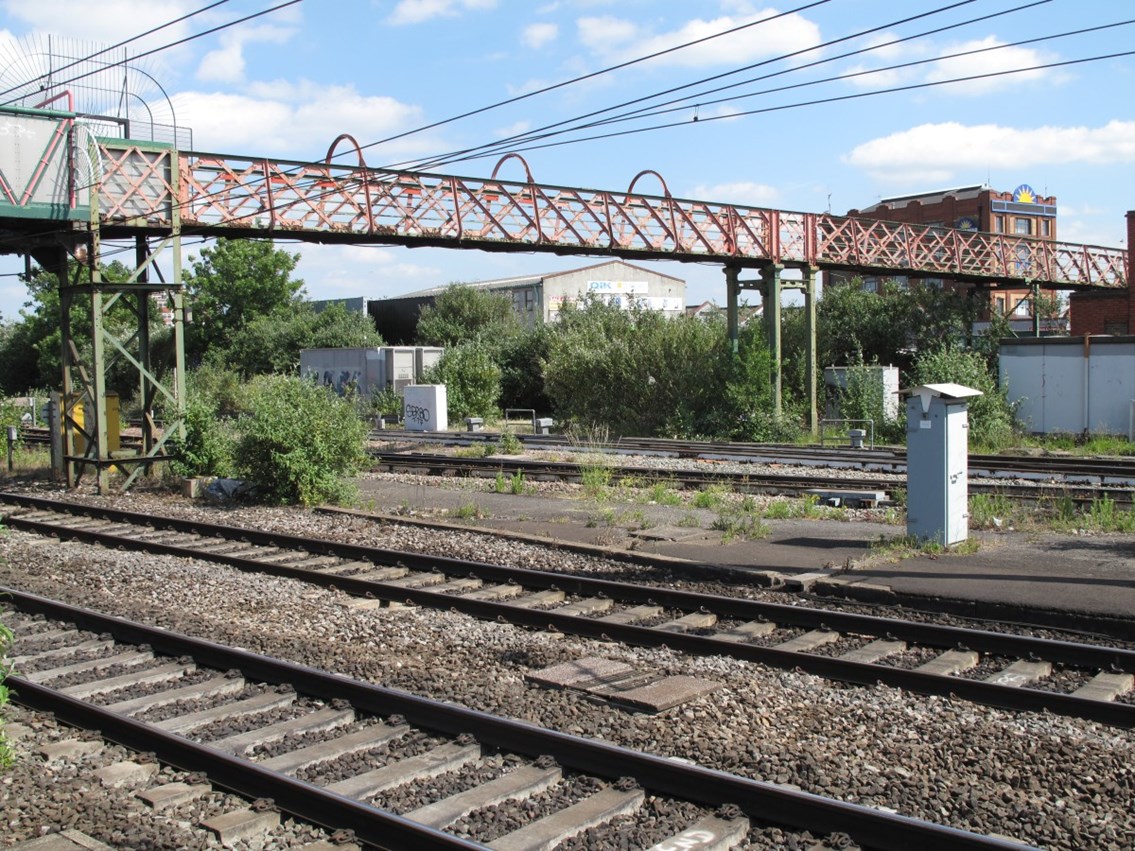Monday 6 Mar 2017
Industry collaboration sees Southall’s Merrick Road footbridge moved to new home at Didcot Railway Centre
- Region & Route:
- Wales & Western: Western
- | Wales & Western
After two years in the planning, Network Rail, its principal contractor Taylor Woodrow and their subcontractor Murphy, successfully dismantled the remaining spans of Southall’s iconic Merrick Road footbridge, preparing it for its new life at Didcot Railway Centre.
As part of the Crossrail West surface works, the footbridge was removed in three parts over two consecutive weekends.
The third section of the bridge is of particular significance to the Great Western Society, as it is the location of the Society’s creation in 1961. The four founding members, who were schoolboys at the time, are said to have stood on the bridge in view of the steam trains in the old Southall depot and created the Great Western Society which aims to preserve the late Victorian/Edwardian railway network.
After its successful removal by crane, this span was hauled to the Didcot Railway Centre where it will eventually be displayed in a new exhibition at the museum.
Contractors Taylor Woodrow and Murphy worked closely together and arranged for the historic bridge to be hauled from Southall to its new home in Didcot and waived management fees to enable the project to happen.
In March 2016, Ealing Council approved funding for a new cycle and pedestrian bridge, including lifts and ramps, at Merrick Road.
Andrew Durrant, Scheme Project Manager at Network Rail said: “'With all the work that Crossrail is doing to make a better railway for tomorrow, it's sometimes easy to forget the treasures of yesterday. When the Great Western Society approached the project, at short notice, to ask that one of the spans be preserved in their museum at Didcot as an example of very fine late Victorian and early Edwardian engineering we were only too happy to accommodate their request. Special thanks go to our contractors, Taylor Woodrow and Murphy, who arranged for the span to be hauled to the Didcot Railway Centre to support railway heritage preservation schemes such as this.”
Rex Clarke, Senior Engineer at Taylor Woodrow said: “Given the age of the footbridge, a detailed structural assessment accounting for the deterioration of the span was carried out to safeguard its integrity as it was lifted off its support. The footbridge was removed within 24 hours, however much of the work was reliant on an 8.5-hour rail “possession” which provided a safe working environment for our team as the trains were not running. The time constraints were challenging, though the thorough planning paid off as all works were executed efficiently and safely.”
Tom Wilson, Heritage Advisor at Network Rail, said: “This salvage operation took two years of planning and organisation. It was only possible thanks to engineers, planners and heritage specialists working together. Our integrated working processes allow us not only to minimise harm to historic buildings, but also to carefully handle them when they must be altered so that new uses can be found for their fabric where possible. We do this for historic places and ‘artefacts’ on every part of the rail network where we work, from bricks to bridges.”
From December 2019, when the full route opens, up to ten Elizabeth line services an hour in each direction will serve Southall, making it quicker and easier to get to destinations across London, South Bucks and Berkshire
Ends
About Crossrail and Network Rail:
Network Rail is a key partner in delivering Crossrail. It is responsible for the design, development and delivery of the parts of Crossrail that are on the existing rail network. Network Rail’s work, which will integrate the new Crossrail tunnels beneath London with the existing rail network, includes upgrades to track, major civil engineering projects, new overhead electrification equipment and improvements to stations and bridges.
Three quarters of the Crossrail route will run above ground in outer London, Buckinghamshire, Berkshire and Essex, bringing 1.5 million more people within 45 minutes of central London.
When it opens fully in 2019, Crossrail will increase central London's rail transport capacity by 10 per cent, supporting regeneration and cutting journey times by providing new links with the Tube, Thameslink, National Rail, DLR and London Overground.
The total funding available to deliver Crossrail is £14.8bn. The Crossrail route will serve 40 stations and run more than 100km from Reading and Heathrow in the west, through new twin-bore 21 km (13 miles) tunnels below central London to Shenfield and Abbey Wood in the east.
Crossrail is being delivered by Crossrail Limited (CRL). CRL is a wholly owned subsidiary of Transport for London. Crossrail is jointly sponsored by the Department for Transport and Transport for London.
Contact information
Passengers / community members
Network Rail national helpline
03457 11 41 41
Latest travel advice
Please visit National Rail Enquiries
Journalists
Network Rail press office -Western route
MediaRelationsWestern@networkrail.co.uk
About Network Rail
We own, operate and develop Britain's railway infrastructure; that's 20,000 miles of track, 30,000 bridges, tunnels and viaducts and the thousands of signals, level crossings and stations. We run 20 of the UK's largest stations while all the others, over 2,500, are run by the country's train operating companies.
Usually, there are almost five million journeys made in the UK and over 600 freight trains run on the network. People depend on Britain's railway for their daily commute, to visit friends and loved ones and to get them home safe every day. Our role is to deliver a safe and reliable railway, so we carefully manage and deliver thousands of projects every year that form part of the multi-billion pound Railway Upgrade Plan, to grow and expand the nation's railway network to respond to the tremendous growth and demand the railway has experienced - a doubling of passenger journeys over the past 20 years.
Follow us on Twitter: @networkrail
Visit our online newsroom: www.networkrailmediacentre.co.uk

